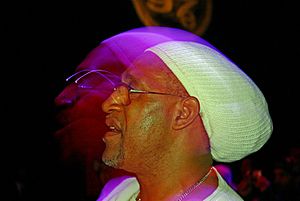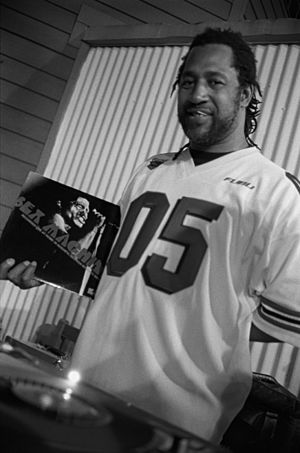DJ Kool Herc facts for kids
Quick facts for kids DJ Kool Herc |
|
|---|---|

DJ Kool Herc in New York, 2006
|
|
| Background information | |
| Birth name | Clive Campbell |
| Also known as |
|
| Born | April 16, 1955 Kingston, Jamaica |
| Origin | The Bronx, New York City, U.S. |
| Genres | Hip hop |
| Occupation(s) | DJ |
| Years active | 1973–present |
| Associated acts |
|
Clive Campbell (born April 16, 1955), known by his stage name DJ Kool Herc, is a Jamaican-American DJ. He is famous for creating hip hop music in the Bronx, New York City, in 1973. Because of his important role, he is often called the "Father of Hip-Hop."
Campbell played funk music, especially from artists like James Brown. He noticed that dancers loved the part of the song with just the drum beat. He called this part the "break." Using two turntables, he played the same record on both. This let him switch between them to make the break last much longer. This new style of DJing, called breakbeat, became the foundation of hip hop music.
Kool Herc also started a new way of talking over the music. His announcements to the crowd helped create the style we now know as rapping. He called the dancers "b-boys" and "b-girls," names still used today in breaking. His style inspired other famous artists like Afrika Bambaataa and Grandmaster Flash. On November 3, 2023, DJ Kool Herc was honored by being added to the Rock and Roll Hall of Fame.
Contents
Biography
Growing Up in Jamaica and New York

Clive Campbell was born in Kingston, Jamaica. As a child, he listened to the local DJs at neighborhood parties. These DJs would talk over the music in a style called toasting. When he was 13, his family moved to the Bronx in New York City. They lived at an apartment building at 1520 Sedgwick Avenue.
In high school, Campbell was tall and good at basketball, so his friends nicknamed him "Hercules". He later joined a graffiti group and took the name Kool Herc. He loved music and convinced his father to buy him a James Brown record called "... Machine". It was a popular record that his friends would come over to hear.
He started his own sound system in the recreation room of his apartment building. He had two turntables, amplifiers, and speakers. He played records that had strong, funky beats. His parties, which his sister Cindy helped organize, became very popular with teenagers in the Bronx.
Creating "The Break"
DJ Kool Herc invented a new way to play music that became a key part of hip hop music. He saw that dancers got most excited during the part of a song that was mostly drums. This part is called the "break".
Herc decided to make this exciting part last longer. He used two turntables with two copies of the same record. When the break was about to end on one record, he would start it over on the second record. By switching back and forth, he could turn a short drum solo into a long, continuous loop of music. He called this technique the "Merry-Go-Round."
One of his first "Merry-Go-Round" mixes used three different songs. He started with a James Brown song, then mixed in a break from "Bongo Rock," and then switched to a break from the song "The Mexican." This created a whole new sound for people to dance to.
While DJing, Kool Herc would also talk to the crowd with fun phrases. He would shout things like, "Rock on, my mellow!" and "To the beat, y'all!" This rhyming talk over the beat was an early form of rapping.
On August 11, 1973, Kool Herc and his sister Cindy threw a "back-to-school" party at their apartment building. This party is now seen as the official birth of hip hop.
The First B-Boys and B-Girls
Kool Herc called the people who danced to his breakbeats "b-boys" and "b-girls." The "b" stood for "break." These dancers created a new style of dancing in the middle of a circle of people. At first, the moves were simple, but soon they became more complex, with spins and other athletic moves.
This style of dancing was later called "breakdance" by the media. The terms b-boy and b-girl are still used today in hip hop culture to describe people who are part of the scene, not just dancers.
Taking Music to the Streets
Kool Herc became a local hero in the Bronx. He started playing his music at clubs, community centers, and high schools. He and his crew, called The Herculoids, would also set up their powerful sound system in parks and schoolyards.
They would get electricity from streetlights and throw free concerts for everyone. People would gather around to watch him work the turntables. These outdoor parties helped spread the new hip hop sound all over the Bronx.
Lasting Impact
Inspiring Other Artists
Kool Herc's style had a huge influence on other DJs. In 1975, a young DJ named Grandmaster Flash started copying Herc's techniques. Soon, Flash and his group, The Furious Five, were playing for big crowds. Another important figure, Afrika Bambaataa, also heard Herc in 1973. Bambaataa started DJing in the same style and formed the Zulu Nation, a group that promoted peace and unity through hip hop.
In 1979, the song "Rapper's Delight" by The Sugarhill Gang was released. It was a huge hit and brought hip hop music to a worldwide audience. As hip hop became more popular, other artists began recording. By this time, DJ Kool Herc was no longer in the spotlight. He was injured during a fight at a club and decided to step back from the scene.
Later Life and Recognition
Kool Herc appeared as himself in the 1984 movie Beat Street. After his father passed away, he went through a difficult period in his life.
In the 2000s, he became active again. He helped get hip hop history recognized by the Smithsonian Institution museums. He also worked to save his old apartment building, 1520 Sedgwick Avenue, from being sold. In 2007, the state of New York officially named the building the "birthplace of hip-hop."
In early 2011, Kool Herc had serious health problems. The hip hop community came together to support him. He recovered and in 2019, he released his first vinyl record with producer Mr. Green.
Discography
Albums
- Last of the Classic Beats (with Mr. Green) (2019)
Guest Appearances
- Terminator X: "Herc's Message" from Super Bad (1994)
- The Chemical Brothers: "Elektrobank" from Dig Your Own Hole (1997)
- Substantial: "Sacrifice" from Sacrifice (2008)
See also
 In Spanish: DJ Kool Herc para niños
In Spanish: DJ Kool Herc para niños


